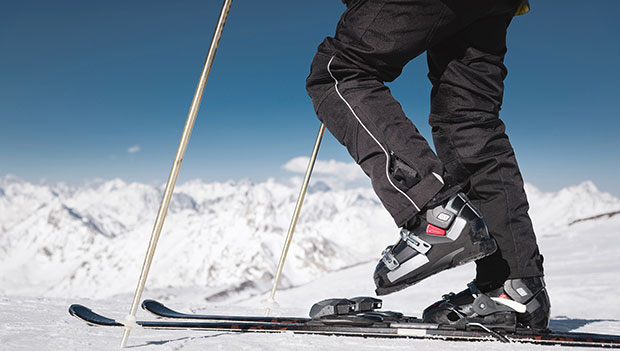
Whether you’re deciding on your first pair of ski boots or are a seasoned veteran looking to upgrade this season's boot setup, finding the best ski boot is essential. But, with a plethora of boots out there to choose from, it can be overwhelming. After all, you have to consider factors like flex, sizing, and material among others. As you decide on the best ski boot, consider upgrading the rest of your ski arsenal: gloves, jackets, goggles, helmets!
Not to worry—we did the hard work for you by rounding up 10 of our favorite ski boots. With a little something for every skier, our list includes everything from comfortable downhill boots to the best and most efficient lightweight alpine touring boots. Plus, we break down everything you need to consider when searching for the best ski boot.
Why Trust Us?
ACTIVE.com's editorial team relies on the knowledge and experience of fitness and wellness experts including competitive athletes, coaches, physical therapists, nutritionists, and certified trainers. This helps us ensure the products we feature are of the highest standard. Collectively, the team has spent countless hours researching equipment, gear, and recovery tools in order to create the most accurate, authentic content for our readers. Customer satisfaction is also a key part of our review process, which is why we only feature products that are highly rated.
The Best Ski Boots - Our Top Picks
By clicking on the product links in this article, we may receive a commission fee at no cost to you, the reader. Sponsorships and affiliate commissions help support our research so we can help you find the best products. Read full affiliate disclosure here.
- Best Overall Ski Boots: Salomon S/PRO 100 GW Ski Boots
- Best Ski Boots for Men: Hawx Ultra Xtd 130 Alpine Touring Boot
- Best Ski Boots for Beginners: Rossignol Evo 70
- Best Touring Ski Boots: Scott Freeguide Carbon Alpine Touring Boot
- Best Ski Boots for Women: Salomon QST Access 70 W Ski Boots
- Best Budget Ski Boots: Nordica Cruise 70
- Most Comfortable Ski Boots: Atomic Hawx Magna 75
- Best Hybrid Ski Boots: Atomic Hawx Prime XTD 130
- Best Lightweight Ski Boots: Dynafit Hoji Free 110
- Most Versatile Ski Boots: Full Tilt Classice Pro Ski Boot
Best Overall Ski Boots - Salomon S/PRO 100 GW Ski Boot
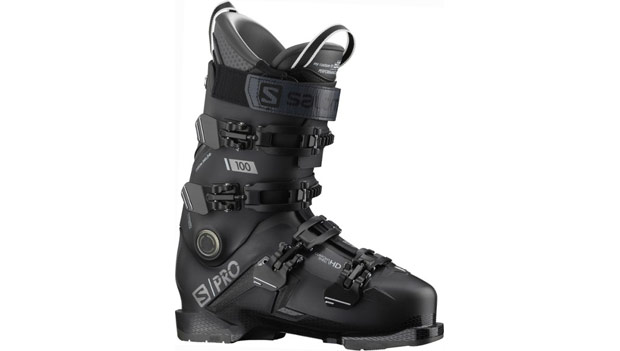
SPECS
- Construction: Customizable Shell HD and Coreframe 360, polyurethane shell with fiberglass core frame
- Type: Alpine or downhill skiing
- Flex: 100
- Sizing: Average to Wide (100-106mm, last)
- Sole: Gripwalk
The Salomon S/Pro 100 GW Ski Boot was built with comfort and performance in mind. We like how the customizable shell allows you to mold the boot to your foot. These boots also come with a seamless liner system to alleviate any unwanted rubbing on seams in the inner boot.
Designed for the intermediate to the upper intermediate on-piste skier, the Salomon S/Pro is a boot that offers extremely easy step-in access and the gripwalk sole makes for a safer experience when walking around on ice and snow. The flex adjuster in the back allows for the ability to adjust the flex and the 4 micro-adjustable aluminum buckles create a snug fit that’s built on responsiveness. If you’re looking for an all-around comfortable, functional book, we think the Salomon S/Pro is a great option.
What We Like
- Comfortable
- Customizable HD Shell for moldability
- Seamless liner
- Lightweight
What We Don't Like
- For the best fit, you have to get the boots heat molded
- Might be a learning curve to understand how the flex adjuster works when making adjustments
BUY: Salomon S/PRO 100 GW Ski Boot
Best Ski Boots for Men - Atomic Hawx Ultra Xtd 130 Alpine Touring Boot

SPECS
- Construction: Prolite (Polyamide shell and cuffs), Energy Backbone, Memory Fit 3D Platinum Light Liner, 7000 Series Aluminum Buckles, 50mm Cam Powerstrap, Free/Lock 2.0 Latch System
- Type: Alpine touring/alpine
- Flex: 130
- Sizing: Narrow (95-99mm) with low volume
- Sole: Skywalk GripWalk, Investment Cast Tech inserts
For men who ski often, we recommend the Atomic Hawk Ultra Xtd 130. Built with a variety of skiers in mind, the Hawx Ultra works well for slipping into the backcountry on touring missions as well as trudging around at the resort. Constructed with Prolite material, these boots are also incredibly lightweight.
The Gripwalk soles make for a comfortable walking experience and the free/lock 2.0 latch system ensures a dependable locking system for downhill travel. However, it’s worth mentioning that while this boot overall is great for achieving dual purposes, it’s not for everyone. The die-hard backcountry skier may want a boot specifically designed for touring and the aggressive in-bounds skiers may want something stiffer.
What We Like
- Lightweight
- Dual purpose (AT, in-bounds)
- Gripwalk Soles
- Free/lock 2.0 walk mode
What We Don't Like
- A little soft for a 130 Flex
- Four buckle system can be a bit overkill in the backcountry
BUY: Atomic Hawx Ultra Xtd 130 Alpine Touring Boot
Best Ski Boots for Beginners - Rossignol Evo 70
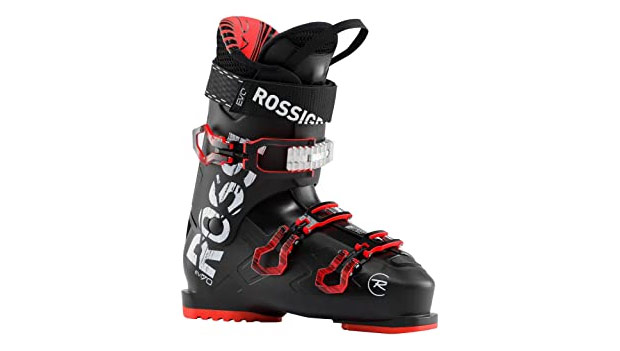
SPECS
- Construction: Polyolefine Shell, Custom T4 Liner, Three Buckle Design
- Type: Alpine
- Flex: 70
- Sizing: Wide (104mm, last)
- Sole: Gripwalk Compatible
If you’ve never hit the slopes before, the Rossignol Evo 70 is a nice choice for novice skiers who are looking for an affordable boot. The sleek sensor matrix allows for a lightweight boot that still commands control on the slopes. And, the three Micro-Adjust Aluminum Buckles paired with the 35-millimeter powerstrap allow for some wiggle room for those skiers with larger calves who struggle to fit into other boots.
Another bonus of the Evo 70? The softer plastic around the in-step makes for easier entry and exit in and out of the boot—a welcome feature that prevents the sometimes painful process of getting into certain boots.
What We Like
- Affordable
- Three buckle system with powerstrap
- Ideal beginner boot
- Great for those skiers with wider feet
What We Don't Like
- Gripwalk-compatible but sold separately
- Soft boots can be limited once a skier begins to advance
Best Touring Ski Boots - Scott Freeguide Carbon Alpine Touring Boot
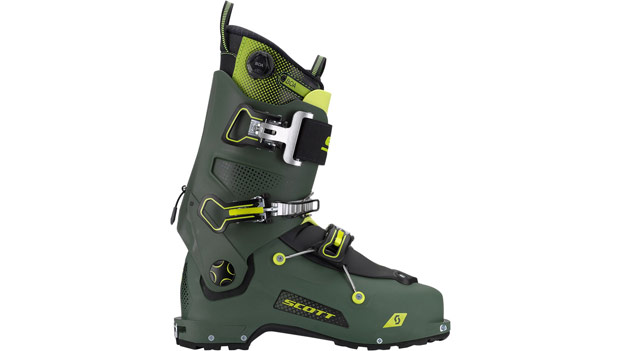
SPECS
- Construction: Powerfree Grilamid + Carbon Fiber Shell, BOA Fit System Liner, Integrated rear hook ski/walk mechanism
- Type: Alpine touring
- Flex: 130
- Sizing: Average (101mm, last)
- Sole: Skywalk rubber
The Scott Freeguide Carbon Alpine Touring Boot is an amply designed boot built with precision and power for an enjoyable up and downhill experience. We like its Grilamid Carbon Fiber construction which makes for a lighter boot and the 101 mm last provides the ideal fit for skiers with wide feet.
The two Ergal micro-adjustable buckled boot system imitates a four-buckle system with the bottom buckle tightening with dual cables. This design paired with a thermo and memo fit liner makes it easy to make adjustments.
What We Like
- Made for those with wide feet
- Powerfree Grilamid + Carbon Fiber Shell
- Comfortable, supportive sole
- Buckle system
What We Don't Like
- Higher price point
- BOA systems can be finicky
BUY: Scott Freeguide Carbon Alpine Touring Boot
Best Ski Boots for Women - Salomon QST Access 70 W Ski Boots
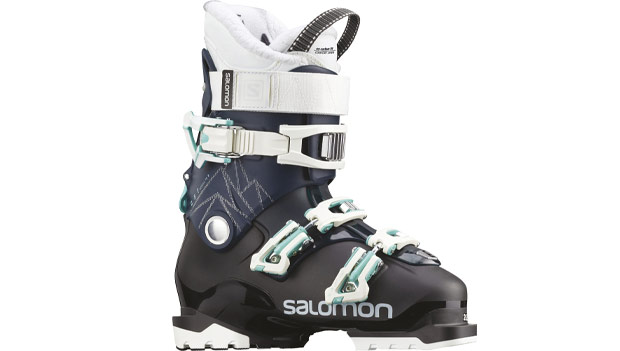
SPECS
- Construction: Polyolefin Shell, My custom fit women specific liners w/ Woolmetal layer, 2 Alumix + 1 Ratchet Buckle, 360 35mm Power Strap, Hike and Ride Mode
- Type: Alpine
- Flex: 70
- Sizing: Wide (104mm, last)
- Sole: Premounted Alpine Pads
If you’re looking for a ski boot designed specifically for women, we recommend the Salomon QST Access 70. Built around a lightweight polyolefin shell, this boot has a ratchet buckle combined with two alumix buckles and a 360-degree 35-millimeter power strap. This creates a better response time when meandering around the slopes.
A hike and ride mode creates the convenience and ability to adjust the backbone of the boot for downhill mode and hike/walk mode. We also like the cuff design which is built specifically to better fit and support a woman's calves.
What We Like
- Hike/walk and ride Mode
- Ratchet buckle
- Slide-In boot liner
- Ability to be customized to your foot
What We Don't Like
- Premounted Alpine Pads, Gripwalk sold separately
- Soft boots can be limiting
Best budget ski boots - Nordica Cruise 70
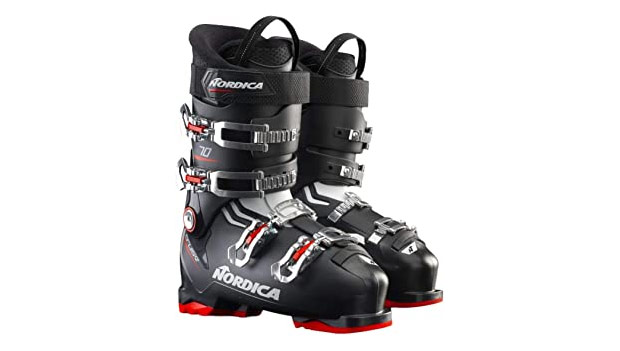
SPECS
- Construction: Triax Shell, Comfort Fit Liner, 4 Micro ALU Buckles, 35mm Power Strap
- Type: Alpine
- Flex: 70
- Sizing: Wide (104mm, last)
- Sole: Standard Alpine Soles
You don’t have to spend a fortune to find good ski boots. The softest boot in the Cruise series, the Nordica Cruise 70 is a perfect entry-level ski boot for those beginner skiers or for those operating at an intermediate skier level. Constructed around a TRIAX shell, these boots use a softer lightweight plastic with a comfort-fit liner for ease of use and access.
We especially like the four buckle system which helps keep your feet and ankles in place. And, its low price tag makes this a quintessential boot for those on a budget who still want a high-quality boot.
What We Like
- Budget-friendly
- Dual entry In-step
- Provides a lot of comfort
What We Don't Like
- Softer boots can be limiting depending on the goals of the skier
- Generic Alpine Soles (Gripwalk sold separately)
BUY: Nordica Cruise 70
Most Comfortable Ski Boots - Atomic Hawx Magna 75

SPECS
- Construction: Polyurethane Shell, 6000 Series Aluminum buckles (4), 35mm Power Strap, Bronze Liners, EZ Step-In
- Type: Alpine
- Flex: 75
- Sizing: Wide (102mm, last)
- Sole: Single Density Standard grip pads
A relatively simple and straightforward boot, the Atomic Hawx Magna 75 tops our list for the most comfortable ski boot. A part of the infamous Atomic Hawx Series, the Magna 75 differs slightly because the boots polyurethane shell makes for a forgiving flex while still providing ample leg and ankle support. The bronze liner makes for a nice cushioned feel and the cuff helps create a more customized fit and feel.
What We Like
- Simple design
- Comfortable
- Budget-friendly
- Bronze liner
What We Don't Like
- High volume fit might not be for everyone
BUY: Atomic Hawx Magna 75
Best Hybrid Ski Boots - Atomic Hawx Prime XTD 130
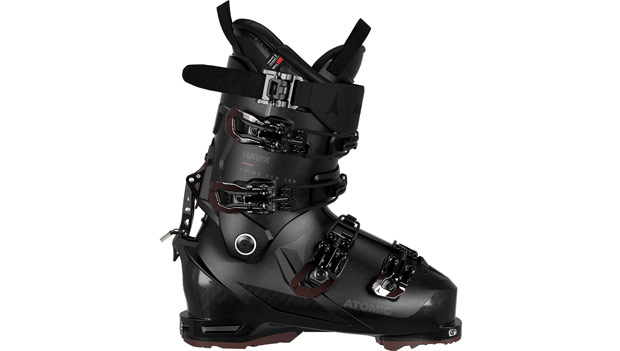
SPECS
- Construction: Prolite shell construction, 6000 series Alu micro buckles, 50mm cam strap, mimic boot liners, Free/Lock 4.0 Ski to Walk Mechanism
- Type: Hybrid (Alpine touring/alpine)
- Flex: 130
- Sizing: 100mm (Last)
- Sole: CT Gripwalk pads
If you’re looking for a ski boot that can do it all, we recommend the Atomic Hawk Prime XTD 130. It’s built with precision and responsiveness in mind and is constructed with prolite technology and a mimic line for a solid, secure feel.
Memory heat-fitting technology allows you to mold these boots to your feet and the four 6000 series alu buckles with a 50 millimeter powerstrap allow for prime adjustability on the up and down. Finally, the free/lock 4.0 ski-to-walk mechanism makes it easy to switch between ski and walk mode.
What We Like
- Allows for AT and in-bounds skiing
- Responsive boot
- Memory fit heat-fitting technology
- Stiff construction makes for a more secure feel
What We Don't Like
- A little heavy for touring and somewhat light for a resort ski
- A lot of buckles for a backcountry ski
BUY: Atomic Hawk Prime XTD 130
Best Lightweight Ski Boots - Dynafit Hoji Free 110

SPECS
- Construction: Grilamid Fiberglass Shell, Custom Thermo-moldable Sidas Liner, Ultra lock strap with safety lock buckles, Hoji lock system
- Type: Alpine Touring
- Flex: 110
- Sizing: 102mm (last)
- Sole: Pomoca rubber sole
Freeskier Eric Hjorleifson also known as “Hoji'' has managed to forge together an excellent ski boot that combines performance with a lightweight feel. The Dynafit Hoji Free 110 is the ideal ski for backcountry enthusiasts looking for a softer boot that still performs at an elite level.
The Grilamid Fiberglass shell provides an ample amount of rigid structure without compromising on weight and comfort. The custom thermo-moldable Sidas boot liner allows for ease of entry and movement while touring around on the skin track or maneuvering through downhill terrain. And, the safety lock buckles combined with the Hoji Lock system provide an effortless ability to go from walk to ski mode as well as easy adjustability in the buckles.
What We Like
- Three buckle system with power strap
- Grilamid Fiberglass Shell
- Pomoca rubber sole
What We Don't Like
- Depending on your preference, 110 can be quite soft flex
Most Versatile Ski Boots - Full Tilt Classic Pro Ski Boot

SPECS
- Construction: TPU Cuff & Lower / Grilamid Tongue, Intuition Pro Liners, 40mm Powerstrap, Ribbed Tongue w/adjustable flex, Aluminum Wide-Track Buckles
- Type: Alpine
- Flex: 8/100
- Sizing: 99mm
- Sole: Single material heel
There is a reason Full Tilt named this boot the Classic Pro. A three-piece design modeled after the beloved 80's Raichle boot, this fully versatile boot can handle everything from park to all-mountain skiing with a style in a league of its own.
Built with a ribbed tongue that allows for a smooth ride as well as the ability to adjust the flex from 4-12 (soft to stiff), the Full Tilt Classic Pro makes it easy to customize the boot to your skills and comfort preferences. Paired with the Intuition foam pro liner, wide-track aluminum buckles, and a 40-millimeter powerstrap, these boots also provide a high level of performance and versatility.
What We Like
- Three-piece boot
- Ribbed tongue
- Intuition pro liners
- Comfortable
What We Don't Like
- Might take a fair bit of adjusting and movement to get the boots where you want them
- Single material heel
BUY: Full Tilt Classic Pro Ski Boot
How to Choose the Best Ski Boot
Construction
The majority of ski boots are constructed of a polyurethane plastic (PA) shell with a liner inside the boot and a series of buckles to tighten the boot comfortably around the foot. Ski boots are constructed like this to enhance their functionality, performance, and comfort for the user. This design also offers protection for your feet as well as flexibility for the ankles and feet to respond quickly to movement.
Type
In the alpine ski world, there are three types of boots that offer three different experiences from downhill to backcountry to a hybrid that combines both alpine and backcountry (also known as Alpine Touring).
- Alpine (downhill): These boots are designed specifically for downhill skiing at resorts and can suit a wide range of skiers from the recreational user to the downhill ski racer.
- Alpine Touring (backcountry): Alpine Touring boots, also known as AT boots or backcountry boots, are specifically designed for backcountry skiing and differ from alpine boots in that they have a walk/hike mode and a downhill mode. They also typically have a connector on the toe box of the boot that attaches to the binding system which differs from the alpine setup.
- Hybrid: These boots are unique in the sense that they can function as alpine boots and as touring boots. Since hybrids provide a dual experience, they tend to be a little heavier than an AT boot but also not as bulky as a downhill boot.
Flex
The flex of a boot can vary from skier to skier but typically depends on the skier's skill level as well as the comfort and performance that you’re looking to gain from the boot. The numerical flex scale shifts in numbers from men, women, and children but starts as low as 30 (for kids) which indicates a softer boot and climbs up to the stiffest level at 130. This metric scale is relative to how much flex there is in the boot or when the shin moves forward and engages the boot. The flex also plays a role in the response time you’re looking to get.
- Soft: A soft boot usually indicates a skier that’s at a beginner to lower intermediate level who sticks towards relatively mellow terrain. Numerical soft flex boots are 40-60 for women and 50-70 for men. Soft boots tend to be more comfortable but they won’t have the same response in turns as a stiffer boot.
- Medium: Medium boots are a great choice for an intermediate to an upper intermediate skier. These boots are around 60-80 for women and 80-100 for men. A medium flex works for many different kinds of terrain and slopes.
- Stiff: An advanced to expert skier should choose a stiffer boot that allows for a greater threshold for elite performance. While a stiffer boot may not be as comfortable as a soft or medium flex, it does open up opportunities for better responsiveness when skiing. Stiff boots range from 80-110 for women and 100-130 for men. In both cases, the higher end of that range is considered very stiff and is typically worn by racers and expert skiers.
Sizing
Choosing the right size with ski boots is extremely important—too small and you risk experiencing toe crunch, pain, and potential bruising. If you go too big, your performance may be affected, plus you’ll likely have blisters at the end of the day. The best ski boot should feel snug and hold the heel in place with the toes just slightly touching the end of the boot.
It’s also important to understand that each style of boot fits feet differently. Some boots are designed for more narrow feet while others may cater to a wider foot. Here’s a quick guide to finding the right size for your ski boot:
- Narrow: Skier's with narrow feet should look for a last (or width) that measures about 97-98mm across.
- Average: An average (or medium) last size measures at about 99 -101mm across the forefront of the foot.
- Wide: A wide foot typically measures to around 102-106mm. Many skiers with wide feet also need a boot with a little more volume as well.
Sole
The sole of a ski boot typically refers to the bottom of the ski boot and the material that’s used for grip. Sole is important to consider because it dictates the level of confidence and control you’ll have when walking around on snow or ice as well as the experience when stepping into a binding.
FAQs About Ski Boots
How do you put on ski boots?
If it’s your first time stepping into ski boots, the sensation might feel a bit foreign. However, you’ll get more comfortable the more you wear them. Putting ski boots on with ski-specific socks can also make the experience a little more smooth.
Before stepping in, loosen and undo all buckles then open the boot by grabbing the loop of the tongue and top of the liner in the rear. Pull those open and work the foot in from the top while standing up. Once your foot is in the boot, try and sit down with the heel butted up against the ground and the toes up. This creates more downward force on the heel so that it's snug against the back of the liner. Now, you can adjust the buckles so that it’s loose enough for circulation but tight enough to prevent your foot from moving around the liner.
How should ski boots fit?
Boots should fit around the foot, ankle, and calf with enough snugness so that there isn't too much movement within the liner. It’s also necessary to make sure that circulation isn't compromised. A boot that fits well should hold sturdy in the heel and the toes should just barely brush the end of the liner with enough space to lightly wiggle the toes.
How often should I replace ski boots?
The duration of a ski boot's longevity depends a lot on the quality of the boot as well as how many times you use your boots per season. An aggressive skier that skis 90 season days will most likely have to replace the boots after a season or two whereas the fairweather skier who hits mellow slopes only 20 days a year or less may be able to get five or six seasons out of a boot. In general, ski boot manufacturers recommend replacement after 150-200 ski days.
Are ski boots comfortable?
We’ll be the first to admit that ski boots used to get a bad wrap for being extremely uncomfortable. However, nowadays (thanks to recent upgrades in technology) ski boots can actually provide quite a cozy experience. A lot of this comes down to finding a boot that’s right for your foot as well as a quality boot fitter who knows what they’re doing.


